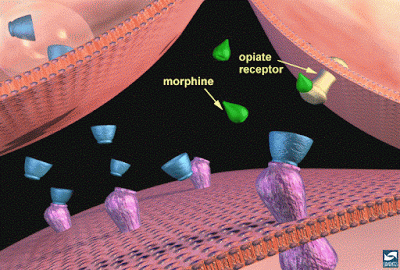When drugs such as heroin, morphine, nicotine are
used repeatedly over time,
TOLERANCE may develop.
Tolerance
occurs when the person no longer responds to the drug in the way that person
initially responded.
It takes a
higher dose of the drug to achieve the same level of response achieved
initially.
For
example, in the case of heroin or morphine,
tolerance develops rapidly to the analgesic effects of the drug.
The
development of tolerance is not addiction, although many drugs that produce
tolerance also have addictive potential.
Tolerance
to drugs can be produced by several different mechanisms, but in the case of
morphine or heroin, tolerance develops at the level of the cellular targets.
For
example, when morphine binds to opiate receptors, it triggers the
inhibition of an enzyme (adenylate cyclase) that coordinates several chemicals
in the cell to maintain the firing of impulses.
After
repeated activation of the opiate receptor by morphine, the enzyme adapts so that the morphine can no longer cause
changes in cell firing.
Thus, the
effect of a given dose of morphine or heroin is diminished.
The
development of tolerance to the analgesic effects of morphine involves
different areas of the brain separate from those in the reward pathway.
The areas
involved in tolerance are the thalamus and the spinal cord.
Both of
these areas are important in sending pain messages and are responsible for the
analgesic effects of morphine.
With repeated use of heroin, morphine
and nicotine
Dependence also occurs.
Dependence develops when the
neurons adapt to the repeated drug exposure and only function normally in the
presence of the drug.
When the drug is withdrawn,
several physiologic reactions occur. These can be mild (e.g., for caffeine) or
even life threatening (e.g., for alcohol).
This is known as the withdrawal syndrome.
In the case of heroin,
withdrawal can be very serious and the abuser will use the drug again to avoid
the withdrawal syndrome.
The development of dependence
to morphine also involves specific areas of the brain, separate from the reward
pathway.
The area involved in the
dependence are thalamus and brain stem.
Many of the withdrawal
symptoms from heroin or morphine are generated when the opiate receptors in the
thalamus and brainstem are deprived of morphine.
Different parts of the brain are responsible for
the addiction and dependence to heroin and opiates.
Thus, it is possible to be dependent on morphine,
without being addicted to morphine. (Although, if one is addicted, they are
most likely dependent as well.)
This is especially true for people being treated
chronically with morphine, for example, pain associated with terminal cancer.
They may be dependent - if the drug is stopped,
they suffer a withdrawal syndrome.
But, they are not compulsive users of the
morphine, and they are not addicted.
Finally, people treated with morphine in the
hospital for pain control after surgery are unlikely to become addicted;
although they may feel some of the euphoria, the analgesic and sedating effects
predominate.







No comments:
Post a Comment